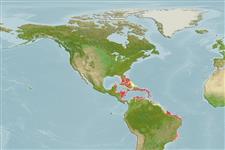Common names from other countries
Teleostei (teleosts) >
Eupercaria/misc (Various families in series Eupercaria) >
Scaridae (Parrotfishes) > Sparisomatinae
Etymology: Sparisoma: Latin, sparus = a fish with a golden head + Greek, soma = body (Ref. 45335).
More on author: Valenciennes.
Environment: milieu / climate zone / depth range / distribution range
Ecology
Marine; reef-associated; depth range 1 - 12 m (Ref. 9710). Tropical; 33°N - 30°S, 89°W - 31°W
Western Atlantic: Bermuda, Florida (USA), Bahamas, and eastern Gulf of Mexico through central America to Santa Catarina, Brazil (Ref. 57756).
Size / Weight / Age
Maturity: Lm ? range ? - ? cm
Max length : 20.0 cm TL male/unsexed; (Ref. 7251); common length : 15.0 cm TL male/unsexed; (Ref. 5217)
Dorsal
spines
(total): 9;
Dorsal
soft rays
(total): 10;
Anal
spines: 3;
Anal
soft rays: 9. Front of upper jaw has horizontal canine-like tusks. 2 scales between bases of pelvic fins (Ref. 26938). Drab-phase fish are olivaceous to yellowish brow, finely speckled with pale dots, many are conjoined; base and axil of pectoral fins broadly blue-green. Terminal-phase males are greenish brown with faint pale dots, some scales with reddish edges; irregular orange-red markings on opercle; a blackish bar at pectoral base; a broad blackish border posteriorly on caudal fin (Ref. 13442).
Mostly found in seagrass beds in shallow, protected waters. Feeds primarily on epiphytes and seagrass blades, leaving crescent bite marks. Darts into seagrass when frightened (Ref. 9710).
Life cycle and mating behavior
Maturity | Reproduction | Spawning | Eggs | Fecundity | Larvae
Robins, C.R. and G.C. Ray, 1986. A field guide to Atlantic coast fishes of North America. Houghton Mifflin Company, Boston, U.S.A. 354 p. (Ref. 7251)
IUCN Red List Status (Ref. 130435)
CITES (Ref. 128078)
Not Evaluated
Threat to humans
Reports of ciguatera poisoning (Ref. 30303)
Human uses
Fisheries: of potential interest; aquarium: commercial
More information
ReferencesAquacultureAquaculture profileStrainsGeneticsElectrophoresesHeritabilityDiseasesProcessingMass conversion
Tools
Special reports
Download XML
Internet sources
Estimates based on models
Preferred temperature (Ref.
115969): 26.1 - 28.2, mean 27.5 (based on 693 cells).
Phylogenetic diversity index (Ref.
82804): PD
50 = 0.5000 [Uniqueness, from 0.5 = low to 2.0 = high].
Bayesian length-weight: a=0.01072 (0.00695 - 0.01651), b=3.13 (3.00 - 3.26), in cm Total Length, based on LWR estimates for this species & Genus-body shape (Ref.
93245).
Trophic level (Ref.
69278): 2.0 ±0.0 se; based on diet studies.
Resilience (Ref.
120179): High, minimum population doubling time less than 15 months (Preliminary K or Fecundity.).
Fishing Vulnerability (Ref.
59153): Low vulnerability (10 of 100).
